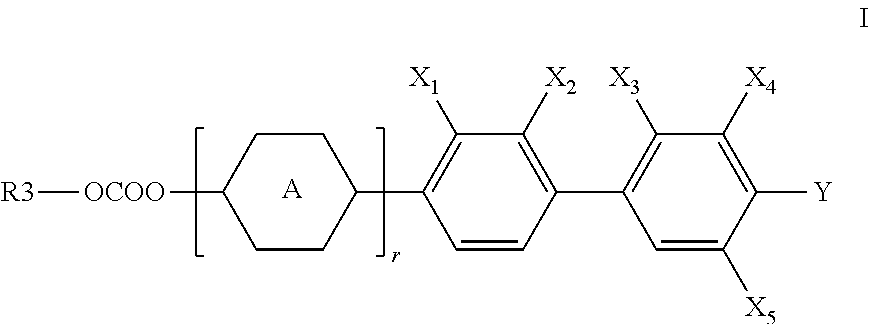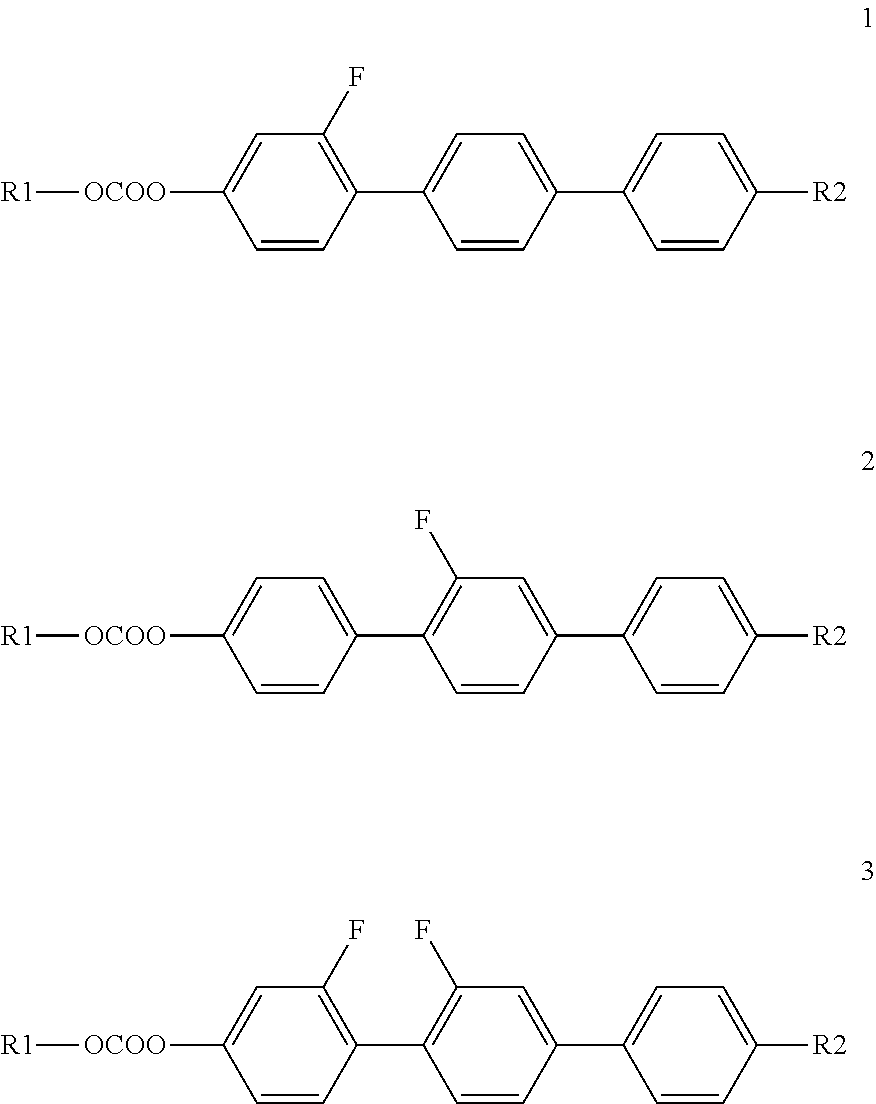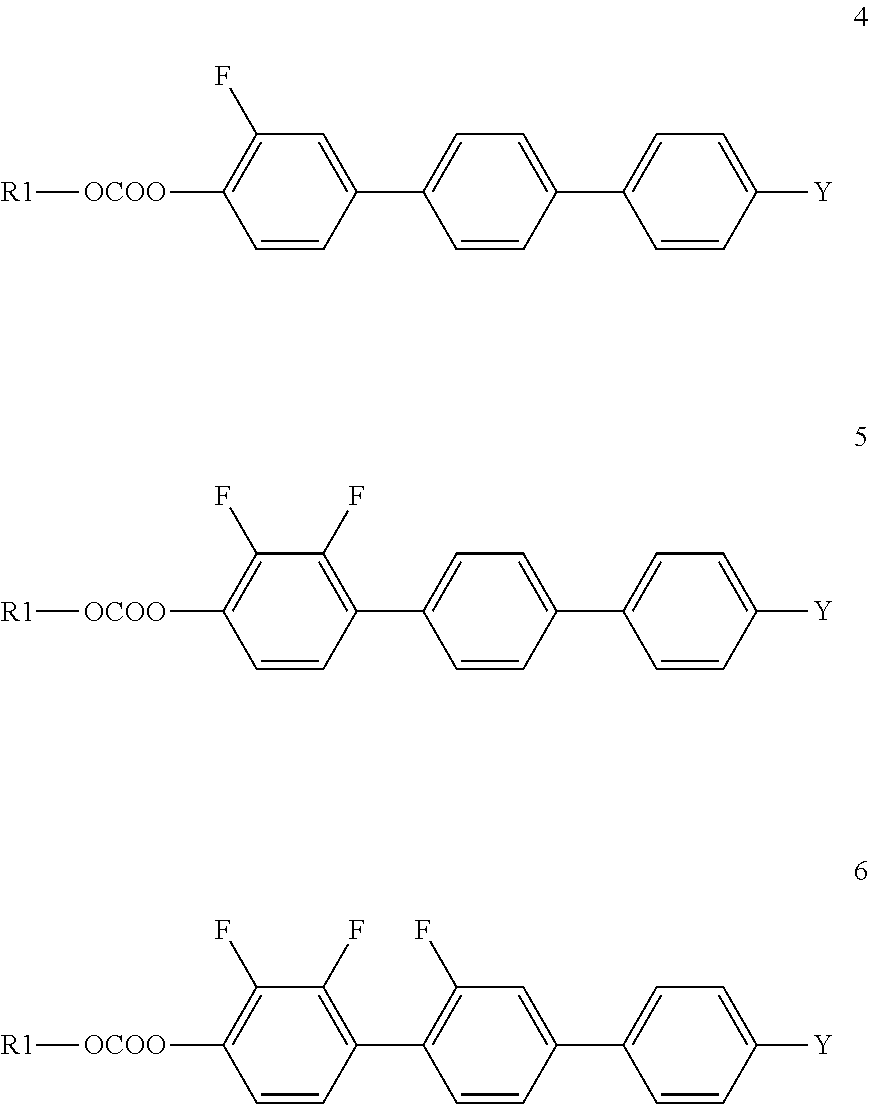Liquid crystal carbonate and liquid crystal medium containing the same with positive or negative dielectric anisotropy
a dielectric anisotropy and liquid crystal technology, applied in the field of new liquid crystal carbonate and liquid crystal medium, can solve the problem that the cannot be too larg
- Summary
- Abstract
- Description
- Claims
- Application Information
AI Technical Summary
Benefits of technology
Problems solved by technology
Method used
Image
Examples
example 1
Synthesis of 2″-fluoro-4″-propyl[1,1′,4′,1″]terphenyl-4-yl propyl carbonate (Compound I.1-3,3)
[0040]Stage I. 1-fluoro-3-propylbenzene
Magnesium chips (13.2 g) were placed into a 1L flask equipped with mechanical stirrer, nitrogen inlet, 500 ml pressure-equilibrated dropping funnel, thermometer and reflux condenser connected to the inert gas outlet. The flask was flushed with nitrogen and minor flow was held during whole reaction time. 1-Bromo-3-fluorobenzene (95 g, 0.542 mol) and dry tetrahydrofurane (300 ml) was placed in dropping funnel. Magnesium was moistened with few milliliters of the solution from dropping funnel and an iodine crystal was added. When exothermic reaction starts 1-bromo-3-fluorobenzene solution was added dropwise to keep the boiling temperature of the mixture. After dropping all of the solution, the mixture was refluxed for 2 hours. Then the mixture was cooled down to −78° C. in a dry ice / acetone bath and propionaldehyde was added dropwise while mixture temperat...
example 2
Synthesis of 2″,3′-difluoro-4″-pentyl[1′,4′,1″]terphenyl-4-yl ethyl carbonate (Compound I.3-2,5)
[0041]Stage I. 3-fluoro-4′-methoxybiphenyl
1-Bromo-3-fluorobenzene (28.8 g, 0.165 mol), potassium carbonate (50 g, 0.362 mol), 4-methoxybenzene boronic acid (27.6 g, 0.182 mol), water (100 ml) and acetone (300 ml) were placed in 1 L round-bottom three necked flask equipped with condenser, thermometer, mechanical stirrer and nitrogen inlet and outlet. The reaction flask was flushed with nitrogen and minor flow was held during whole reaction time. The mixture was heated up to the boiling point to 40° C. to degas the reaction system and then cooled down and the catalyst palladium acetate (0.1 g) was added. The temperature has increased of few degrees and the solution turned brown. The mixture was refluxed for 6 hours, then was cooled down, poured on cold water and the precipitated gray solid was filtered off. The raw product was recrystallized from ethanol (500 ml). The product (28.9 g) in a ...
example 3
Synthesis of 2′,3′-difluoro-4″-pentyl[1,1′,4′,1″]terphenyl-4-yl propyl carbonate (compound I.5-3,5)
[0042]Stage I. 2,3-difluorophenyl boronic acid
1,2-Difluorobenzene (40 g, 0.35 mol) and dry tetrahydrofurane (400 ml) were placed in 1 L flask equipped with mechanical stirrer, nitrogen inlet and outlet, pressure-equilibrated dropping funnel and thermometer. The reaction flask was flushed with nitrogen and minor flow was held during whole reaction time. The mixture was cooled down to −78° C. with dry ice / acetone bath and 2.5 mol / L hexane solution of n-butyllithium (140 ml; 0.35 mol) was added dropwise, keeping the reaction temperature below −70° C. After addition of all butyllithium solution the mixture was stirred at −78° C. for 2 h and then tripropylborate (66 g, 0.35 mol) was added dropwise keeping the reaction temperature below −70° C. After addition of tripropyl borate the cooling bath was removed and the reaction mixture continuously stirred to reach the room temperature then the ...
PUM
| Property | Measurement | Unit |
|---|---|---|
| Dielectric anisotropy | aaaaa | aaaaa |
Abstract
Description
Claims
Application Information
 Login to View More
Login to View More - R&D
- Intellectual Property
- Life Sciences
- Materials
- Tech Scout
- Unparalleled Data Quality
- Higher Quality Content
- 60% Fewer Hallucinations
Browse by: Latest US Patents, China's latest patents, Technical Efficacy Thesaurus, Application Domain, Technology Topic, Popular Technical Reports.
© 2025 PatSnap. All rights reserved.Legal|Privacy policy|Modern Slavery Act Transparency Statement|Sitemap|About US| Contact US: help@patsnap.com



